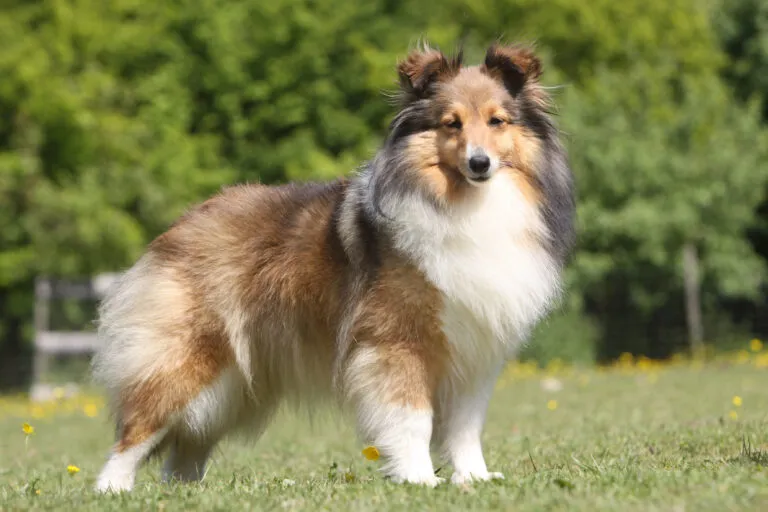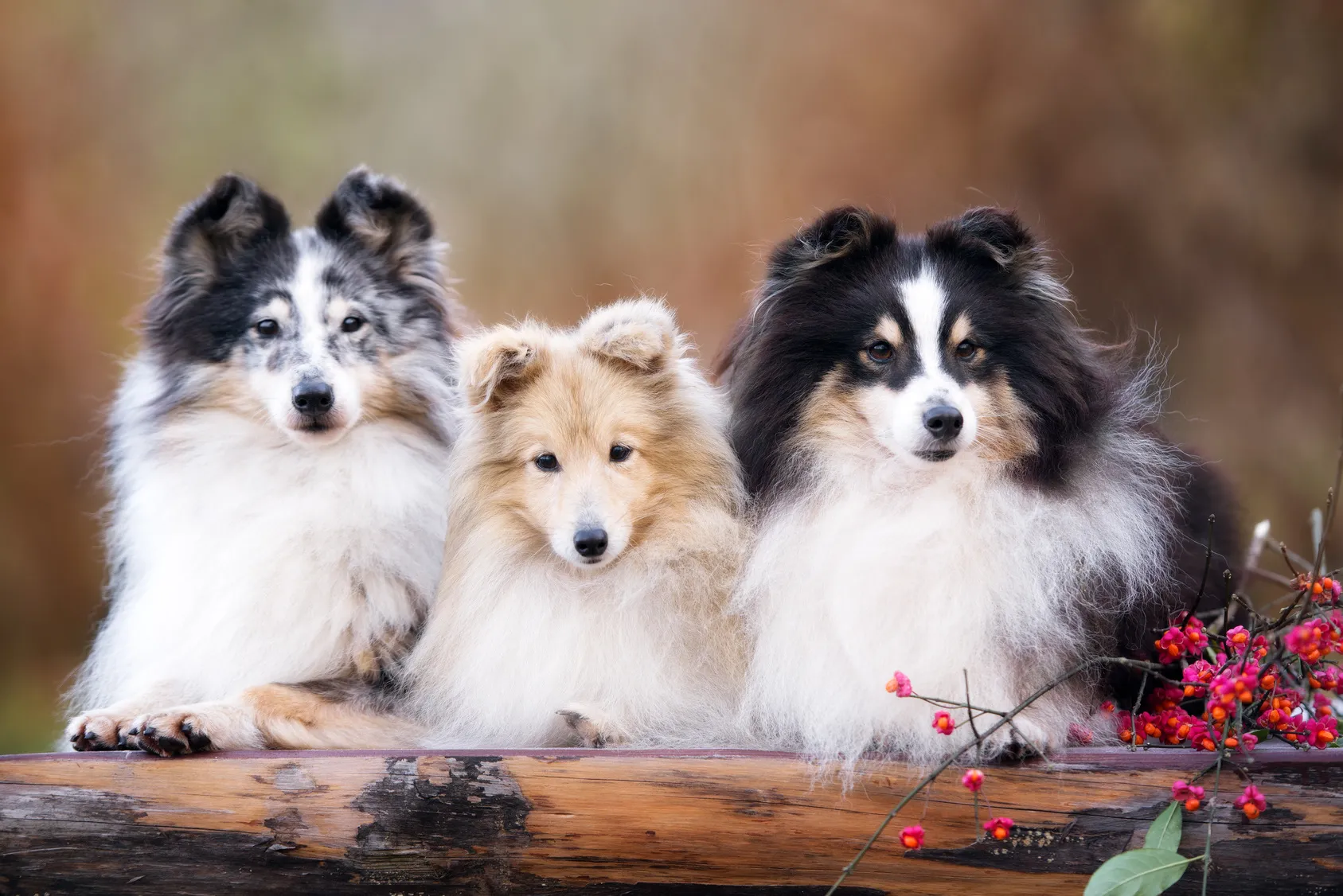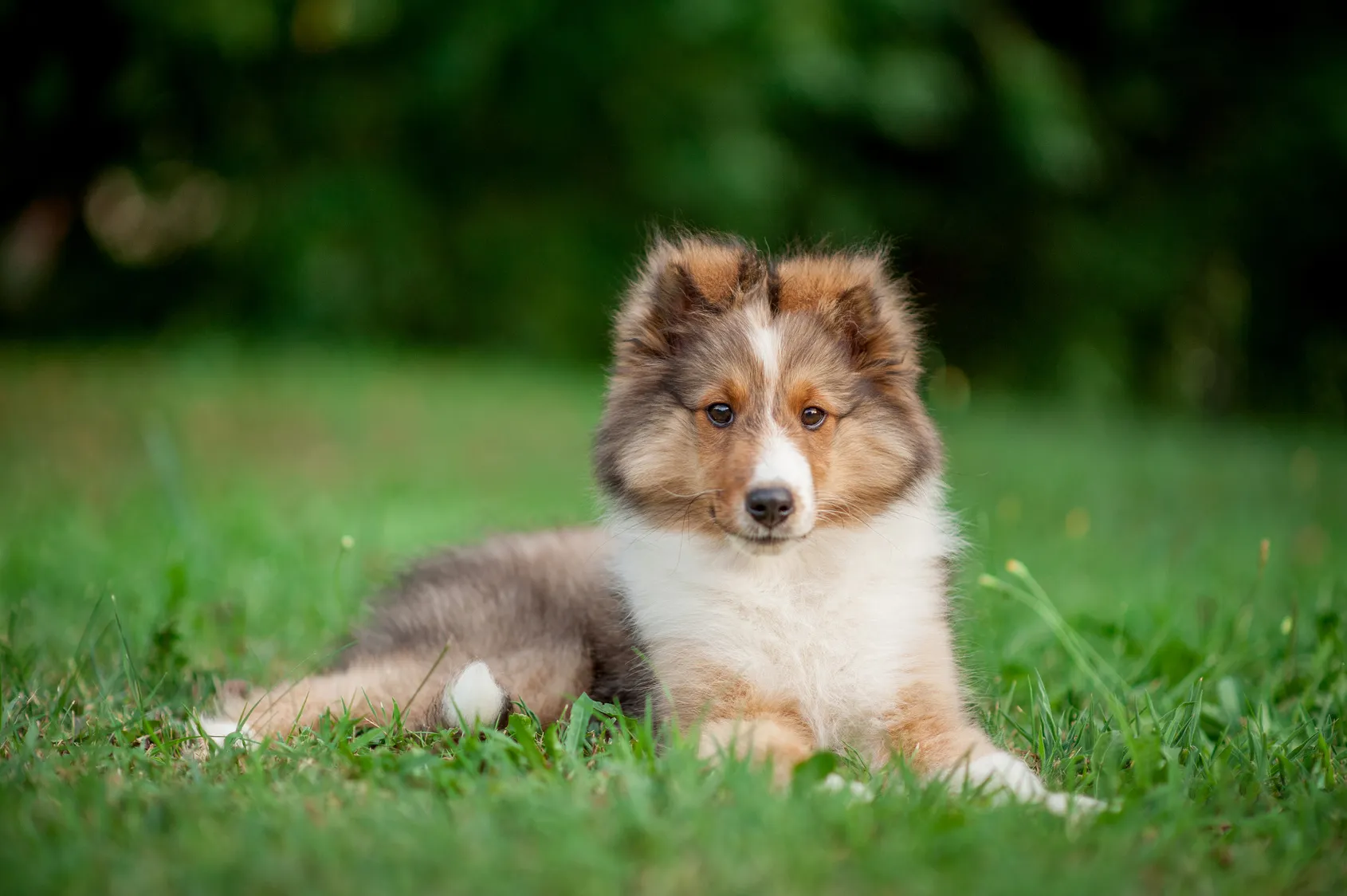Beagle
The Beagle's short legs can be deceiving – this medium-sized dog keeps you on your toes and is always full of surprises! This friendly breed is active, fearless and extremely clever.
With its plush coat and delicate facial features, the Shetland Sheepdog is a little bundle of energy that requires plenty of exercise and activity. However, its willingness to learn and sensitivity makes it an ideal companion dog too.

© CALLALLOO CANDCY / stock.adobe.com
Things are certainly never boring with a Sheltie around. The exuberant temperament of these little dogs from the Shetland Islands is simply infectious and really gives the owner no other choice but to spend many hours outdoors or practicing dog sport with their canine friend. Don’t be deceived by the “dainty” appearance: the Shetland Sheepdog is a robust nature lover unperturbed by wind and rain. They prefer spending time running around than on its owner’s lap.
This doesn’t mean that Shetland Sheepdogs aren’t affectionate – on the contrary, they are very sensitive dogs that always seek proximity to their owner and like to play a close role in their life. Many Shelties even prefer activities with their owner to frolicking with other dogs outdoors. Nevertheless, they are generally friendly and open towards fellow dogs or other pets, so in this respect there is no argument against living with cats or with several dogs. In addition, this applies for living with children, though they should be considerate when the Sheltie needs its quiet time.
By doing so, the vivacious and enthusiastic Sheltie can thoroughly enjoy its quiet time at home and retreat slightly from the chaos of family life when necessary. After all, these pedigree dogs “talk” enough anyway. Their love of barking comes to the fore particularly on watch duty outdoors. Puppy owners are well advised to steer them away from barking at an early stage. However, a heavy hand or shouting orders are entirely out of place when attempting to curb your Sheltie’s love of barking, as is generally the case with training on the whole.
Shetland Sheepdogs are very sensitive dogs that are highly perceptive to the atmosphere in their family and always make an effort to improve it. In return, they expect to be treated with the same love and fairness by their owners. Unrestrained, loud or even aggressive behaviour is abhorrent to sensible Shelties and deeply frightens them. On the other hand, fair and gentle training will lead to success, because Shelties have a real will to please. Its quick comprehension and love of learning makes it a very grateful and cooperative partner suitable for first-time dog owners.
Shetland Sheepdogs have a very attractive head shape that gives this pedigree breed an air of nobility. The thick, long coat and plush ruff around the throat emphasise this majestic appearance. Supple, graceful movement and delicate symmetric contours all fit this image too.
Their lively and robust nature clearly contrast to their noble appearance, making the Sheltie a very special pedigree dog.
The Sheltie’s top coat is long, tough and straight, with the thick soft undercoat offering reliable protection against wind and bad weather. Despite the long coat, its fine lines should still be recognisable. The Sheltie’s fur is multicolored and varied. The following colourations are permitted according to the breed standard:
White markings are desirable with all colour combinations (apart from black and tan) and should appear on their throat, chest, legs and tip of the tail.
 © otsphoto / stock.adobe.com
© otsphoto / stock.adobe.com
A similarity with the Rough Collie in terms of physical appearance cannot be denied. The long coat, fine elongated head with short fur and colouration bear a strong resemblance to Lassie & co. With males reaching a height of around 37cm and females 35cm (though there are significant variations), the Sheltie is slightly smaller than the classic Rough Collie.
Nevertheless, the Sheltie isn’t merely a small version of the Collie, as proven by taking a look at its history. These pedigree dogs from the Shetland Islands located north of Scotland are presumably a mix of a small Shetland farm dog with the Continental Spaniel, Papillon and Pomeranian. Crossing with Collies was predominantly to improve herding characteristics, since the main responsibility of small and agile Shelties was originally to keep herds of sheep together. However, for a long time there wasn’t a uniform type when it came to these small Scottish herding dogs.
Although the Sheltie reached Britain in 1840 and conquered other countries as a show and family dog at the start of the 20th century, official recognition from the British Kennel Club was not granted until 1914. Another 50 years went by before the international FCI definitively recognised the Shetland Sheepdog. Since then, it has been listed in Group 1, Section 1 under standard number 88.
To this day, the Sheltie is considered a rare dog breed in many European countries. On the other hand, it is more popular than the Collie in the US, so it is hardly surprising that the greatest number of breeders can be found there. In order to find a suitable breeder, it’s recommended to get a list of all registered breeders from the official pedigree club in the country where you live. Associations and clubs recognised by the FCI generally have a precise overview of the situation and inform you if puppies are expected or already available. In principle, neither proximity nor a short waiting time for a puppy should be a decisive factor when it comes to the purchase.
 © Danijela / stock.adobe.com
© Danijela / stock.adobe.com
When buying a pedigree dog, it’s essential that the puppy comes from a serious breeder. Newspapers ads offering sweet puppies at a bargain price may be tempting, but they involve all sorts of dangers, since the low prices almost always come at the expense of the puppies and their health. You don’t get a healthy, strong puppy that will bring you joy for a long time at a discount price. After all, conscientious rearing, intensive care and numerous veterinary examinations cost the breeder a lot of money. Prices of €1,000+ are justified for puppies.
However, the impression that the breeder makes on you is even more important than the price. Before you purchase a puppy, you should therefore absolutely meet the breeder in person. Have them show you the breeding site, the mother and any puppies that are already there. Take time too for a one-on-one discussion with the breeder. A good sign is the breeder willingly showing you everything, giving you extensive information on the peculiarities of the breed and wanting to know about your own living situation. After all, they too want to be sure that their beloved puppy is going to be in good hands.
The following requirements should be met in order for a Sheltie to feel at ease with you:
If you fulfil these five criteria and have found a suitable breeder, there’s nothing else standing in the way of you buying a puppy. However, first-time owners in particular should be aware that keeping a dog isn’t all about the fun times. Just like us humans, dogs get sick too. The duties of every dog owner include attending veterinary appointments and paying the bills, potentially changing the diet and caring for sick pets.
Shetland Sheepdogs develop some breed-specific diseases that regularly occur with their Collie relatives too. These include the skin and muscle condition dermatomyositis (generally mild for Shelties), the MDR1 defect (an intolerance towards certain medications) and Collie eye anomaly. In addition, blindness and deafness can be the result of pairing blue merle dogs. Equally, cases of epilepsy and cardiac diseases have been documented amongst Shelties.
 © atiger / stock.adobe.com
© atiger / stock.adobe.com
Of course you can do something to maintain your dog’s health and to avoid illnesses. This begins as soon as you buy your puppy. Make sure that it is healthy and that all necessary examinations and vaccinations have been carried out. Many hereditary diseases can be avoided or at least detected at an early stage and treated. In addition, a balanced diet, regular veterinary check-ups and vaccinations and sufficient grooming are all part of a healthy life.
In principle, long fur entails more work than short fur, though Shelties are actually low-maintenance dogs despite their magnificent coat. Their flat, tough top hair effectively repels dirt and water and doesn’t tend to become matted. Thoroughly brushing the fur once a week is generally sufficient for this breed. You should merely check the hair behind the ears more often and untangle any knots with a comb.
You’d be well advised to get your Sheltie used to grooming as early as possible and to lovingly teach it to sit still.
A healthy diet is a fundamental part of a healthy life. But which food is right for the Shetland Sheepdog? First of all, the Sheltie isn’t particularly demanding in terms of food – on one hand, this is a positive, but on the other it means that there is no one-size-fits-all answer as to what is the right food. When choosing a food, individual factors must be considered. How old is your dog? How active is it? Is it overweight or does it have any allergies? And what does it like to eat?
Some Shetland Sheepdogs are highly selective regarding food, so figure out what food they digest well and find tasty. Deciding whether to give your dog dry food or wet food, whether to cook it yourself or follow the BARF method depends not least on your own perception. Regardless of what you decide, it’s important that your dog’s food provides it with all vital nutrients that it needs. These include protein as the main source of energy, vitamins and minerals, carbohydrates and fibre, as well as a sufficient amount of fresh drinking water.
You can generally see whether your dog has a healthy and balanced diet. Healthy Shelties have attractive shiny fur and buzz with energy. As the owner, you should absolutely take this need for exercise seriously and provide your dog with plenty of physical and mental stimulation. Dog sport is almost compulsory for Sheltie owners, though you are free to choose what type of sport. Be it agility, obedience, flyball, dog dancing or disc dogging, the nimble and willing-to-learn Sheltie is at ease in almost all areas. Training to be a rescue or therapy dog is possible for this intelligent and people-focused pedigree breed.
Physically stimulated dogs are calmer and more sensible at home and tend to be less nervous. Taking part in dog sport strengthens the close relationship between dog and owner, achieving mutual trust. This is the best foundation for a lifelong friendship with your Sheltie.
The Beagle's short legs can be deceiving – this medium-sized dog keeps you on your toes and is always full of surprises! This friendly breed is active, fearless and extremely clever.
The Golden Retriever is still one of the most popular dog breeds, especially with families. It is defined not just by its docility, but shows numerous other qualities too. Read in the following article everything you need to know about the Golden Retriever.
The German Shepherd is one of the most popular utility dog breeds in the world, though the willing-to-learn and people-focused nature of these versatile dogs also makes them suitable for family life.